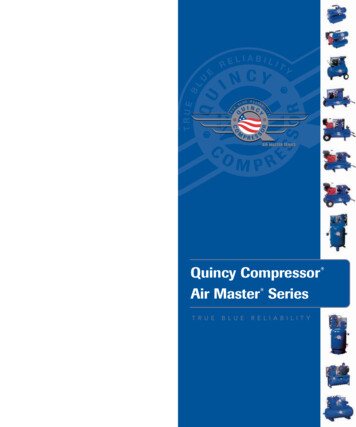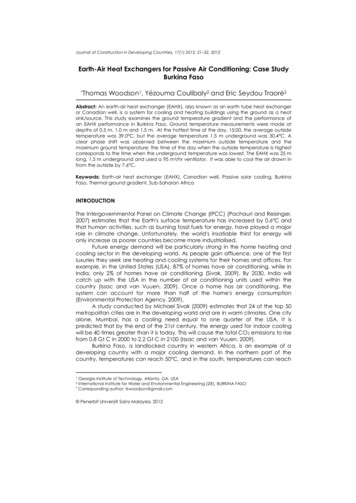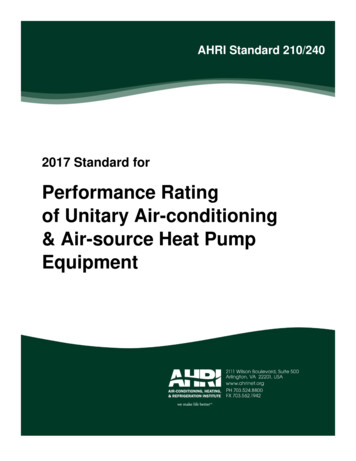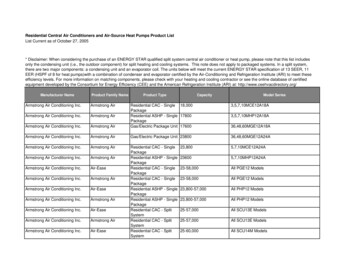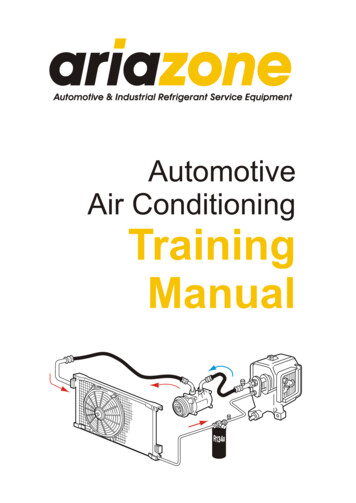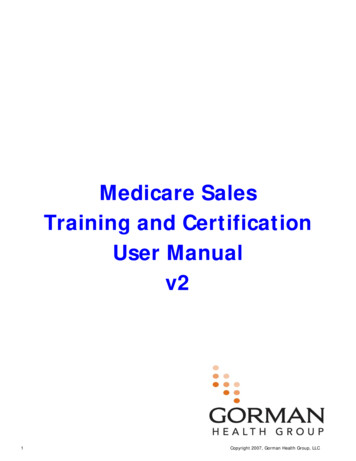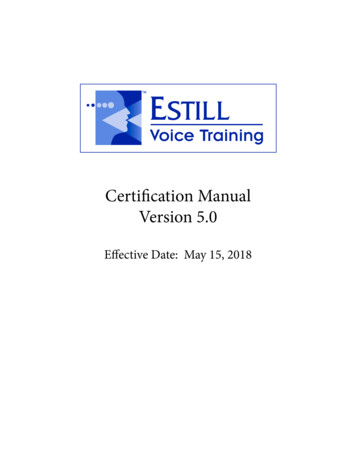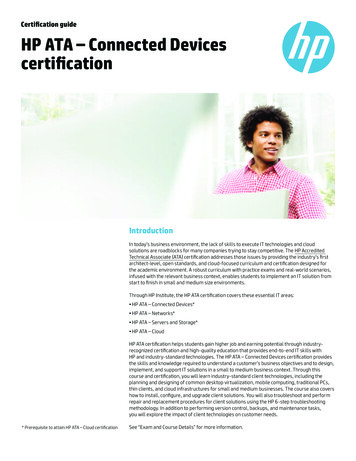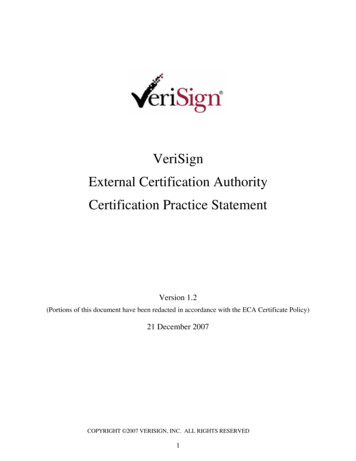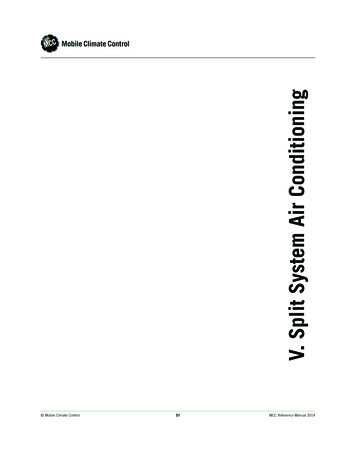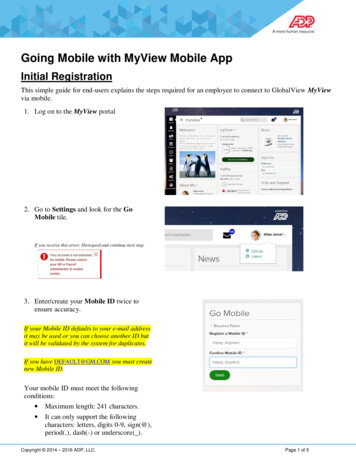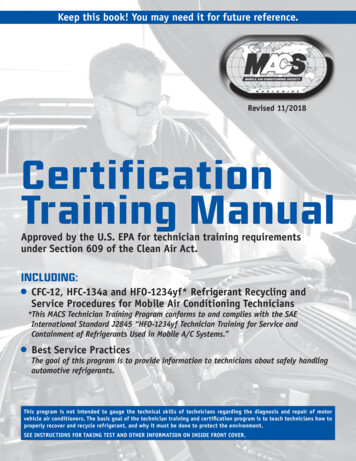
Transcription
Keep this book! You may need it for future reference.Revised 11/2018CertificationTraining ManualApproved by the U.S. EPA for technician training requirementsunder Section 609 of the Clean Air Act.Including:CFC-12, HFC-134a and HFO-1234yf* Refrigerant Recycling andService Procedures for Mobile Air Conditioning Technicians*This MACS Technician Training Program conforms to and complies with the SAEInternational Standard J2845 “HFO-1234yf Technician Training for Service andContainment of Refrigerants Used in Mobile A/C Systems.”Best Service PracticesThe goal of this program is to provide information to technicians about safely handlingautomotive refrigerants.This program is not intended to gauge the technical skills of technicians regarding the diagnosis and repair of motorvehicle air conditioners. The basic goal of the technician training and certification program is to teach technicians how toproperly recover and recycle refrigerant, and why it must be done to protect the environment.SEE INSTRUCTIONS FOR TAKING TEST AND OTHER INFORMATION ON INSIDE FRONT COVER.
Certification Training ManualImportant Notes!Do not mix up tests or exchange tests with other individuals at your place of business. All tests are coded with namesmatching assigned numbers.Please review your test upon completion. Any questions marked with more than one answer will be scored as incorrect.Any question not marked will be scored as incorrect.Completely fill in the block () to the left of the correct answer.Do not mark with a check (4) or an “x” (7).General Information and InstructionsYou have registered for MACS certification in REFRIGERANT RECYCLING & SERVICE PROCEDURES FOR MobileAIR CONDITIONING TECHNICIANS. Following are the steps* necessary for you to complete the prescribedtraining:* The following instructions apply to technicians taking the MACS training course by mail or online. Thoseparticipating in a classroom program should follow the instructions of their trainer/proctor. Tests givenin a classroom setting must be closed-book tests. The required score for passing closed-book tests islower than that required for passing the open-book test.1. Read the instruction manual that came with your recovery/recycling service equipment (and review the trainingvideo, if provided). Then read this manual cover to cover. Re-read as necessary to gain full comprehension of thematerial presented.2. Take the test. The test is an untimed, “open-book” test, so you may refer to the training manual as often as necessaryto research answers to the questions posed. (Note, however, that you must correctly answer a minimum of 21 of the25 questions to earn certification.) You must complete the test by yourself, without assistance from anyone, andsubmit it for scoring. (See 4 below.)3. Complete and sign the “Identification and Statement of Testing Conditions” block on your test.Note: A reprint charge will be incurred if information provided is not legible.4. Mail your test in the self-addressed envelope provided to: MACS-EIF, P.O. Box 88, Lansdale, PA 19446, or submitonline.5. MACS-EIF will advise MACS of your test results.6. MACS will advise you of your score and, providing that you have attained a passing score, will issue a certificateand a wallet-sized I.D. card, indicating that you have successfully completed this MACS certification trainingprogram.Enclosed:Test with identification information to be mailed to scoring facility.Self-addressed return envelope (MACS-EIF).Important - Please note: Tests must be returned for scoring within 90 days of the date they are issued. MACS assumes noresponsibility for tests submitted for scoring after this 90-day period. MACS will charge an additional fee for re-issuingtests which are lost, misplaced or destroyed.Note: The MACS Worldwide office is open from 8:30 a.m. until 5:00 p.m. Eastern Time. 2018 Mobile Air Conditioning Society Worldwide
Certification Training ManualThis publication is protected under the copyright laws ofthe United States and all other applicable internationallaws and treaties. All rights are reserved, including resalerights. No part of this publication may be reproduced ortransmitted in any form, by any means (electronic, photocopying, recording, or otherwise) without the priorwritten permission of Mobile Air Conditioning SocietyWorldwide (MACS Worldwide).Unauthorized use, reproduction or distribution of thispublication, or any portion of it, may result in severecivil and criminal penalties, and will be prosecuted to themaximum extent possible under the law. If you receivedthis publication from anyone other than MACS Worldwide,then you have received a pirated copy. We would appreciate it if you would notify us of the situation.The information contained in this publication is basedon technical data and tests, and is intended for use bypersons with technical skill at their own discretion andrisk. While the author(s) and publisher have made everyreasonable effort to insure the accuracy of the information in this publication, they assume no responsibility for errors or omissions. Please remember that yourparticular situation may differ from any examples illustrated here, and so you should adjust your use of theinformation and any recommendations in this publication accordingly.MACS Worldwide makes no representations or warrantiesconcerning the information contained herein or the applications described or referred to in this publication.MACS Worldwide specifically disclaims any implied warranties, including the warranties of merchantability orfitness for any particular purpose. MACS Worldwide shallin no event be liable for any loss of profit, business interruption or any other commercial damage, includingwithout limitation, special, incidental, consequential,or other damages arising out of the use or inability touse the presentations or applications described or referred to herein.The identification of any product, technique, firm orbusiness entity in this publication does not constitute an endorsement by MACS Worldwide. Any companynames, products, product names, emblems, logos, images, trademarks, service marks or trade dress appearingin this publication are the property of their respectiveowners and are used solely in an editorial fashion. Allsuch items are protected under federal laws of the United States and international agreements; unauthorizeduse is prohibited.If you wish to contact MACS Worldwide about this publication, please refer to the information listed below.MACS WorldwideP.O. Box 88225 S. Broad StreetLansdale, PA, 19446Voice: 215-631-7020E-mail: info@macsw.orgFax: 215-631-7017Website: www.macsw.orgMACS and the MACS logo are registered trademarks of theMobile Air Conditioning Society Worldwide.All Rights Reserved. Printed in the U.S.A. 1990, 2008, 2011, 2013, 2014, 2015, 2016, 2018 Mobile Air Conditioning Society Worldwide 2018 Mobile Air Conditioning Society WorldwideI
Certification Training ManualForewordWorld vehicle manufacturers are currently required to meet international regulatory requirements to use lower globalwarming potential (GWP) refrigerants in new vehicle A/C systems. This MACS Technician Training Program conforms toand complies with the SAE International standard J2845, “HFO-1234yf Technician Training for Service and Containment ofRefrigerants Used in Mobile A/C Systems.”Some of the practices, techniques, procedures, tools, information and equipment required to service HFO-1234yf and otheralternative refrigerant systems are different from those commonly used on CFC-12 and HFC-134a systems. No technicianshould perform service or repair on a mobile air conditioning system without being trained to handle the refrigerant thesystem contains.While SAE standards are voluntary and developed through industry consensus, historically the U.S. EnvironmentalProtection Agency has incorporated SAE standards into federal regulations by reference. Additionally, some individualstates require compliance with SAE standards, particularly those related to safety. For example, many states refer toSAE J639, “Safety Standards for Motor Vehicle Refrigerant Vapor Compression Systems” in various laws and regulations.MACS Worldwide acknowledges and thanks the U.S. EPA, SAE International, and the industry’s many manufacturers andsuppliers who allowed their data and products to appear in this manual.Standard J639: Safety Standards for Motor VehicleRefrigerant Vapor Compression SystemsIssuing Committee: SAE International Interior Climate Control Steering CommitteeThis SAE Standard applies to refrigerant vapor compression systems that provide cooling and/or heating forpassenger cars, light trucks and commercial vehicles (on and off road) that use automotive type mobile air conditioning (MAC) systems. Large trucks, buses and other vehicles that do not use typical automotive A/C systemsor use refrigerants not listed in this document are not covered by this standard. This standard covers any vehiclewith a MAC system using a belt or electric motor driven compressor.This document provides standards for design, assembly, test and service of MAC systems to minimize environmental, health and safety impacts. Also included are cautionary statements for the service industry to alerttechnicians to the inadvisability and possible health or safety effects associated with venting refrigerant duringservice. This document addresses only HFC-134a (R-134a), carbon dioxide (R-744), and HFO-1234yf (R-1234yf)refrigerants.To prevent system contamination, all refrigerants used in mobile air conditioning vapor compression systemsrequire unique service fittings and service equipment. The unique service fittings are intended to eliminate thepotential for system refrigerant cross-contamination during service activity. CFC-12 (R-12) is no longer in usein new MAC systems. The service fitting description is maintained as a reference for older vehicles still in use.When retrofitting an R-12 system to use R-134a or when removing R-12 (vehicle disposal), use service equipmentdesigned for R-12 and certified to meet the requirements of SAE J1990 (R-12 recovery and recycle equipment).HFC-152a is an A2 flammable refrigerant as classified by ASHRAE 34 and should be used only with a secondary loop application. However, until MAC systems are developed to use HFC-152a (R-152a), no SAE Standards forsystem design, service equipment or service procedures have been established. The R-152a service fittings described within this Standard were established as part of the industry’s evaluation of replacement refrigerantsand are maintained for future design guidance and to prevent potential refrigerant cross contamination.II 2018 Mobile Air Conditioning Society Worldwide
Certification Training ManualTable of ContentsThe Switch to Climate-Friendly Refrigerants. . . . . . . . . . . . . . . . . . . . . . . . . . . . . . . . . . . . . . . 1Introduction . . . . . . . . . . . . . . . . . . . . . . . . . . . . . . . . . . . . . . . . . . . . . . . . . . . . . . . . . . . . . . . . . 1Servicing of Future Mobile Air Conditioning Systems . . . . . . . . . . . . . . . . . . . . . . . . . . . . . . . . . . . . . . 2Federal Regulations Affecting Mobile A/C System Service . . . . . . . . . . . . . . . . . . . . . . . . . . . . . . . . . . . 5Service Procedures for Mobile Air Conditioning Systems . . . . . . . . . . . . . . . . . . . . . . . . . . . . . . . . . . . 11Refrigerant Recovery and Recycling Procedures. . . . . . . . . . . . . . . . . . . . . . . . . . . . . . . . . . . . . . . . . 13Best Service Practices for Mobile A/C Systems. . . . . . . . . . . . . . . . . . . . . . . . . . . . . . . . . . . . 17Sources of Refrigerant Emissions. . . . . . . . . . . . . . . . . . . . . . . . . . . . . . . . . . . . . . . . . . . . . . . . . . . 17Incorrect System Charges – Some Reasons Why. . . . . . . . . . . . . . . . . . . . . . . . . . . . . . . . . . . . . . . . . 25Avoiding Refrigerant Contamination . . . . . . . . . . . . . . . . . . . . . . . . . . . . . . . . . . . . . . . . . . . . . . . . 29Best Service Practices for HFO-1234yf Systems. . . . . . . . . . . . . . . . . . . . . . . . . . . . . . . . . . . . 42Introduction . . . . . . . . . . . . . . . . . . . . . . . . . . . . . . . . . . . . . . . . . . . . . . . . . . . . . . . . . . . . . . . . 42HFO-1234yf: Specific Safety Procedures. . . . . . . . . . . . . . . . . . . . . . . . . . . . . . . . . . . . . . . . . . . . . . 43Unique Properties of HFO-1234yf Systems . . . . . . . . . . . . . . . . . . . . . . . . . . . . . . . . . . . . . . . . . . . . 44Tanks, Labels, and Fittings. . . . . . . . . . . . . . . . . . . . . . . . . . . . . . . . . . . . . . . . . . . . . . . . . . . . . . . 46Identifying HFO-1234yf. . . . . . . . . . . . . . . . . . . . . . . . . . . . . . . . . . . . . . . . . . . . . . . . . . . . . . . . . 47Finding Leaks . . . . . . . . . . . . . . . . . . . . . . . . . . . . . . . . . . . . . . . . . . . . . . . . . . . . . . . . . . . . . . . 48Using Recovery, Recycling, and Recharging Equipment. . . . . . . . . . . . . . . . . . . . . . . . . . . . . . . . . . . . 50System Servicing Procedures. . . . . . . . . . . . . . . . . . . . . . . . . . . . . . . . . . . . . . . . . . . . . . . . . . . . . . 52epa snap Rules. . . . . . . . . . . . . . . . . . . . . . . . . . . . . . . . . . . . . . . . . . . . . . . . . . . . . . . . . . . . . . 52Refrigerant Recycling and Service Proceduresfor Mobile Air Conditioning Technicians. . . . . . . . . . . . . . . . . . . . . . . . . . . . . . . . . . . . . . . . 53The Historical Context. . . . . . . . . . . . . . . . . . . . . . . . . . . . . . . . . . . . . . . . . . . . . . . . . . . . . . . . . . 53Ozone Depletion. . . . . . . . . . . . . . . . . . . . . . . . . . . . . . . . . . . . . . . . . .
AIR CONDITIONING TECHNICIANS. Following are the steps* necessary for you to complete the prescribed training: 1. Read the instruction manual that came with your recovery/recycling service equipment (and review the training video, if provided). Then read this manual cover to cover. Re-read as necessary to gain full comprehension of the
